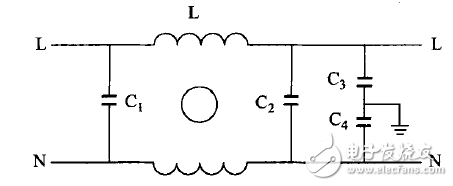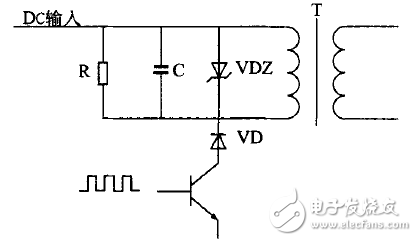In this paper, the generation mechanism of switching power supply EMI is analyzed in detail, and a series of EMI suppression strategies are proposed to effectively improve the electromagnetic compatibility of switching power supplies.
The switching power supply is a power electronic product that uses power semiconductor devices and integrates power conversion technology, electronic electromagnetic technology, and automatic control technology. Because of its advantages of low power consumption, high efficiency, small size, light weight, stable operation, safe and reliable, and wide voltage regulation range, it is widely used in computers, communications, electronic instruments, industrial automation, national defense and household appliances. field. However, the switching power supply has poor transient response and is prone to electromagnetic interference (EMD, and the EMI signal occupies a wide frequency range and has a certain amplitude. These EMI signals pollute the electromagnetic environment through conduction and radiation, to communication equipment and electronic instruments. This causes interference and thus limits the use of switching power supplies to some extent.
1 Causes of electromagnetic interference from switching power supplies
Electromagnetic interference (EMI) is a performance impairment caused by an unexpected electromagnetic disturbance in an electronic system or sub-system. It consists of three basic elements: the source of interference, that is, the device that generates electromagnetic interference energy; the way of combining, that is, the path or medium that transmits electromagnetic interference; the sensitive device, that is, the device, device, subsystem or device that is damaged by electromagnetic interference or system. Based on this, the basic measures for controlling electromagnetic interference are: suppressing the source of interference, cutting off the path of mismatch, and reducing the response of sensitive equipment to interference or increasing the level of electromagnetic sensitivity.
According to the working principle of the switching power supply, the switching power supply first rectifies the commercial frequency alternating current into direct current, and then inverts into high frequency alternating current, and finally rectifies and filters the output to obtain a stable direct current voltage. In the circuit, the power transistor and the diode mainly work in the state of the switch tube, and work in the microsecond order; during the turn-on and turn-off process of the triode and the diode, the current changes greatly during the rising and falling time, and the RF energy is easily generated. Source of interference. At the same time, potential electromagnetic interference is also formed due to the leakage inductance of the transformer and the spike caused by the reverse recovery current of the output diode.
Switching power supplies typically operate at high frequencies with frequencies above 02 kHz, so their distributed capacitance is not negligible. On the one hand, the insulating sheet between the heat sink and the collector of the switch tube has a large contact area and a thin insulating sheet. Therefore, the distributed capacitance between the two cannot be ignored at high frequencies, and the high-frequency current flows through the distributed capacitor. On the heat sink, it flows to the chassis ground to generate common mode interference. On the other hand, there is a distributed capacitance between the primary and secondary of the pulse transformer, which can directly confuse the primary winding voltage to the secondary winding. Common mode interference occurs on the two power lines that make DC output.
Therefore, the interference sources in the switching power supply are mainly concentrated in voltage and current variations, such as switching tubes, diodes, high-frequency transformers and other components, as well as AC input and rectifier output circuit parts.
2 Measures to suppress electromagnetic interference of switching power supply
Generally, switching power supply EMI control mainly uses filtering technology, shielding technology, sealing technology, grounding technology, and the like. EMI interference is divided into conducted interference and radiated interference according to the propagation route. The switching power supply is mainly conducted interference, and the wide frequency range is about 10 kHz to 30 MHz. The countermeasures for suppressing conducted interference are basically solved in three frequency bands of 10 kHz to 150 kHz, 150 kHz to 10 MHz, and 10 MHz or more. The main interference is mainly in the range of 10 kHz to 150 kHz, and is generally solved by a general-purpose LC filter. The common mode interference is mainly in the range of 150 kHz to 10 MHz, and is usually solved by a common mode rejection filter. The countermeasures for the frequency band above 10 MHz are to improve the shape of the filter and to take electromagnetic shielding measures.
2.1 Using AC input EMI filter
There are usually two ways in which the interference current is transmitted on the wire: the common mode and the differential mode. Common mode interference is the interference between the carrier fluid and the earth: the interference size and direction are the same, and exist in any relative ground of the power supply, or between the neutral line and the earth, mainly generated by du/dt, and the di/dt also produces a certain total. Mode interference. The differential mode interference is the interference between the carrier fluids: the interference is equal in magnitude and opposite in direction, and exists between the power phase line and the neutral line and between the phase line and the phase line. When the interference current is transmitted on the wire, it can be either common mode or differential mode; however, the common mode interference current can only interfere with the useful signal after it becomes the differential mode interference current.
The above two types of interference exist on the AC power input line, usually low-band differential mode interference and high-band common mode interference. Under normal circumstances, the differential mode interference amplitude is small, the frequency is low, and the interference caused is small; the common mode interference amplitude is large, the frequency is high, and the radiation can be generated by the wire, and the interference caused is large. If an appropriate EMI filter is used at the input end of the AC power source, electromagnetic interference can be effectively suppressed. The basic principle of the power line EMI filter is shown in Figure 1. The differential mode capacitors C1 and C2 are used to short-circuit the differential mode interference current, while the intermediate connection grounding capacitors C3 and C4 are used to short-circuit the common mode interference current. The common mode choke is composed of two coils that are equal in thickness and wound in the same direction on a magnetic core. If the magnetic coupling between the two coils is very tight, the leakage inductance will be small and the difference will be within the power line frequency range.
The mode reactance will become very small; when the load current flows through the common mode choke, the magnetic lines of force generated by the coils connected in series on the phase line are opposite to the lines of magnetic force generated by the coils connected in series on the center line, and they are in the core. Cancel each other out. Therefore, even in the case of a large load current, the core does not saturate. For the common mode interference current, the magnetic fields generated by the two coils are in the same direction, which will exhibit a large inductance, thereby attenuating the common mode interference signal. Here, the common mode choke coil is made of a ferrite magnetic material having a high magnetic permeability and a good frequency characteristic.

Figure 1 Basic circuit diagram of power line filter
2.2 Using the absorption loop to improve the switching waveform
During the turn-on and turn-off of the switch or diode, due to the transformer leakage inductance and line inductance, the diode storage capacitor and distributed capacitance, it is easy to generate a spike voltage at the collector, emitter and diode of the switch. The RC/RCD absorption loop is usually used, and the RCD surge voltage absorption loop is shown in Figure 2.

Figure 2 RCD surge voltage absorption loop
When the voltage on the absorption loop exceeds a certain range, the devices are quickly turned on, thereby venting the surge energy and limiting the surge voltage to a certain amplitude. The saturable core coil or the microcrystalline magnetic bead is connected in series on the positive electrode lead of the collector of the switch tube and the output diode, and the material is generally cobalt (Co). When the normal current is passed, the core is saturated, and the inductance is small. Once the current flows in the opposite direction, it will generate a large back EMF, which effectively suppresses the reverse surge current of the diode VD.
Ups Lithium Ion Battery,Uninterruptible Power Battery,Stability Lithium Ion Battery,High Power Stability Battery
Wolong Electric Group Zhejiang Dengta Power Source Co.,Ltd , https://www.wldtbattery.com
